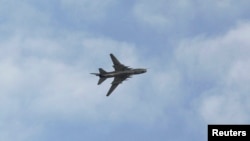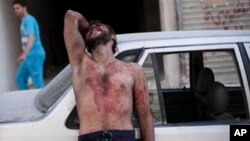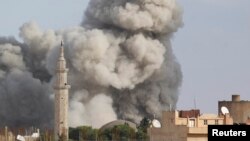BEIRUT —
The Syrian Air Force is carrying out air strikes on its own cities and towns that violate international humanitarian law or amount to war crimes, according to a leading human rights organization.
The organization Human Rights Watch, said its conclusion is based on about 60 Syrian Air Force attacks inside the country that were either too indiscriminate, killing or endangering nearby civilians, or were deliberately targeted at non-combatants.
In a 75-page report, “Death from the Skies: Deliberate and Indiscriminate Air Strikes on Civilians,” Human Rights Watch said it documented the bombing raids in rebel-controlled areas in the Syrian provinces of Aleppo, Idlib, and Latakia. The report, issued today (April 10), was based on visits to bombing sites and field investigations, including more than a hundred interviews. Researchers also examined video footage of the air raids. (Listen to our interview with HRW's Nadim Houri using the audio player at the end of this post.)
The limited number of raids investigated by rights group led to the deaths of at least 152 civilians, it said. Overall, more than 4,000 civilians may have been killed in air raids since last summer, according to the Syrian Violations Documentation Center, a Syrian monitoring group working in coordination with a network of Syrian opposition activists.
The United Nations estimates that more than 70,000 overall have been killed in Syria since the civil war began just over two years ago. More than a million are estimated to have been left homeless.
Deliberate attacks on bakeries and hospitals
Human Rights Watch said the air strikes it studied are carried out by warplanes and helicopters and include deliberate attacks on bakeries and hospitals. It said that in some cases the Syrian aircraft dropped cluster and incendiary bombs, which was described as a method of “systematic and widespread attacks against the civilian population.”
In March, VOA found some evidence that cluster bombs, which break open in the air and spread so-called bomblets, may have been used in an attack on the town of Azaz near the border with the Turkey. Cluster munitions have been banned by most nations because of their indiscriminate nature, although the U.S. military has claimed in the past that cluster munitions can often result in less collateral damage than a larger bomb or artillery shell.
“In village after village, we found a civilian population terrified by their country’s own air force,” said Ole Solvang, an emergencies researcher with Human Rights Watch who interviewed many of the victims and witnesses. “These illegal air strikes killed and injured many civilians and sowed a path of destruction, fear, and displacement.”
Between July and December, Human Rights Watch report documented 119 incidents of the Syrian armed forces dropping cluster munitions in populated areas in the governorates of Aleppo, Idlib, Deir al-Zor, Homs, Latakia and Damascus.
Four bakeries were among the targets of the 59 air strikes in the report. Civilians were often queuing in breadlines at the time of the attacks.
The raids also included repeated attacks on two hospitals. In Aleppo, Syria’s largest city, warplanes attacked the clearly marked Dar al-Shifa hospital, forcing the clinic to cease functioning.
In the town of Salma in the governorate of Latakia, high-flying helicopters dropped improvised bombs near a makeshift hospital, eventually destroying it on October 5, 2012, Human Rights Watch said.
Rebels escape many air strikes
The rights group report noted that the air strikes it documented led to no casualties among rebel fighters, as far as its researchers could establish.
In 41 of the attacks documented in the report, Human Rights Watch identified possible military targets, such as rebel bases or checkpoints within 50 to 400 meters of the strike. But it said that international law experts conclude that an attacking party is not relieved from a legal obligation to take into account risk to civilians.
In al-Bab, a town northeast of Aleppo, the Syrian Air Force launched several sorties near a rebel base on September 3, 2012, but the base was never hit - a house was, killing four members of the Said family.
On November 7, a Syrian air force warplane dropped two bombs on the town of Akhtarin in northern Aleppo governorate, destroying three houses and killing seven, including five children. In this case there was a possible military target, a building 50 meters away used by opposition fighters, the Human Rights Watch report said.
“It was tragic. The buildings had turned into a heap of rubble,” said a neighbor quoted in the report. “We started pulling people out using just our hands and shovels. A cupboard and a wall had fallen on the children. They were still alive when we found them, but they died before we could take them to their uncle’s house.”
Human Rights Watch has issued several hard-hitting reports on the Syrian civil war and not all of its criticism has focused on the government. Last autumn, the group criticized the rebel Free Syrian Army for failing to take “all feasible measures to avoid deploying forces and structures such as headquarters in or near densely populated areas.”
The latest report concludes by saying that, “The information we have gathered should also assist those seeking to bring the perpetrators of these crimes to justice,” a possible invitation for the United Nations or the International Criminal Court to consider war crimes charges against senior members of the regime of President al-Assad.
VOA's Susan Yackee speaks to Human Rights Watch's Nadim Houri about the group's latest findings in Syria:
The organization Human Rights Watch, said its conclusion is based on about 60 Syrian Air Force attacks inside the country that were either too indiscriminate, killing or endangering nearby civilians, or were deliberately targeted at non-combatants.
In a 75-page report, “Death from the Skies: Deliberate and Indiscriminate Air Strikes on Civilians,” Human Rights Watch said it documented the bombing raids in rebel-controlled areas in the Syrian provinces of Aleppo, Idlib, and Latakia. The report, issued today (April 10), was based on visits to bombing sites and field investigations, including more than a hundred interviews. Researchers also examined video footage of the air raids. (Listen to our interview with HRW's Nadim Houri using the audio player at the end of this post.)
The limited number of raids investigated by rights group led to the deaths of at least 152 civilians, it said. Overall, more than 4,000 civilians may have been killed in air raids since last summer, according to the Syrian Violations Documentation Center, a Syrian monitoring group working in coordination with a network of Syrian opposition activists.
The United Nations estimates that more than 70,000 overall have been killed in Syria since the civil war began just over two years ago. More than a million are estimated to have been left homeless.
Deliberate attacks on bakeries and hospitals
Human Rights Watch said the air strikes it studied are carried out by warplanes and helicopters and include deliberate attacks on bakeries and hospitals. It said that in some cases the Syrian aircraft dropped cluster and incendiary bombs, which was described as a method of “systematic and widespread attacks against the civilian population.”
In March, VOA found some evidence that cluster bombs, which break open in the air and spread so-called bomblets, may have been used in an attack on the town of Azaz near the border with the Turkey. Cluster munitions have been banned by most nations because of their indiscriminate nature, although the U.S. military has claimed in the past that cluster munitions can often result in less collateral damage than a larger bomb or artillery shell.
“In village after village, we found a civilian population terrified by their country’s own air force,” said Ole Solvang, an emergencies researcher with Human Rights Watch who interviewed many of the victims and witnesses. “These illegal air strikes killed and injured many civilians and sowed a path of destruction, fear, and displacement.”
Between July and December, Human Rights Watch report documented 119 incidents of the Syrian armed forces dropping cluster munitions in populated areas in the governorates of Aleppo, Idlib, Deir al-Zor, Homs, Latakia and Damascus.
Four bakeries were among the targets of the 59 air strikes in the report. Civilians were often queuing in breadlines at the time of the attacks.
The raids also included repeated attacks on two hospitals. In Aleppo, Syria’s largest city, warplanes attacked the clearly marked Dar al-Shifa hospital, forcing the clinic to cease functioning.
In the town of Salma in the governorate of Latakia, high-flying helicopters dropped improvised bombs near a makeshift hospital, eventually destroying it on October 5, 2012, Human Rights Watch said.
Rebels escape many air strikes
The rights group report noted that the air strikes it documented led to no casualties among rebel fighters, as far as its researchers could establish.
In 41 of the attacks documented in the report, Human Rights Watch identified possible military targets, such as rebel bases or checkpoints within 50 to 400 meters of the strike. But it said that international law experts conclude that an attacking party is not relieved from a legal obligation to take into account risk to civilians.
In al-Bab, a town northeast of Aleppo, the Syrian Air Force launched several sorties near a rebel base on September 3, 2012, but the base was never hit - a house was, killing four members of the Said family.
On November 7, a Syrian air force warplane dropped two bombs on the town of Akhtarin in northern Aleppo governorate, destroying three houses and killing seven, including five children. In this case there was a possible military target, a building 50 meters away used by opposition fighters, the Human Rights Watch report said.
“It was tragic. The buildings had turned into a heap of rubble,” said a neighbor quoted in the report. “We started pulling people out using just our hands and shovels. A cupboard and a wall had fallen on the children. They were still alive when we found them, but they died before we could take them to their uncle’s house.”
Human Rights Watch has issued several hard-hitting reports on the Syrian civil war and not all of its criticism has focused on the government. Last autumn, the group criticized the rebel Free Syrian Army for failing to take “all feasible measures to avoid deploying forces and structures such as headquarters in or near densely populated areas.”
The latest report concludes by saying that, “The information we have gathered should also assist those seeking to bring the perpetrators of these crimes to justice,” a possible invitation for the United Nations or the International Criminal Court to consider war crimes charges against senior members of the regime of President al-Assad.
VOA's Susan Yackee speaks to Human Rights Watch's Nadim Houri about the group's latest findings in Syria:













